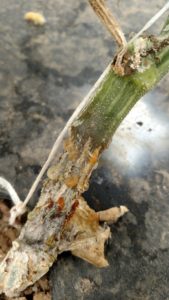This disease was identified on a long Asian cucumber growing in a high tunnel in Mid-June in Knox County. The first symptom noted was wilting of the cucumber plant. Upon closer examination, a light, gray necrosis was observed on the lower portion of the plant. In Figure 1, you may notice dark spots in the necrotic area. These symptoms, plus the resin-like drops on the stem might look like gummy stem blight. However, a look under the microscope revealed fungal structures and spores that were not from the gummy stem blight fungus. Plus, gummy stem blight is rare in a greenhouse situation where there is little moisture. When we isolated for a fungus, we found numerous micro-sclerotia. The sample was sent up to campus to confirm that the fungus was Macrophomina phaseolina, causal agent of charcoal rot.

Figure 1. Charcoal rot of cucumber often causes a light gray necrotic area on the crown in which may be observed numerous dark fungal bodies.
The charcoal rot fungus has many hosts and the fungus is not new to Indiana. However, cucumber have never been reported as a host. Perhaps the most common host in Indiana is soybean. Other hosts are strawberry, potato, corn and sorghum.
Charcoal rot seems to be favored by hot, dry soils. The fungus that causes charcoal rot may survive several years in the soil without a host. The hot, dry soil inside a high tunnel may have favored charcoal rot.
Management of charcoal rot is dependent on crop rotation with less susceptible hosts. Plants should be managed so as to avoid stresses such as fertility, irrigation and other diseases. Some varieties may be less susceptible to charcoal rot.
If you suspect charcoal rot, be sure to get an official diagnosis.